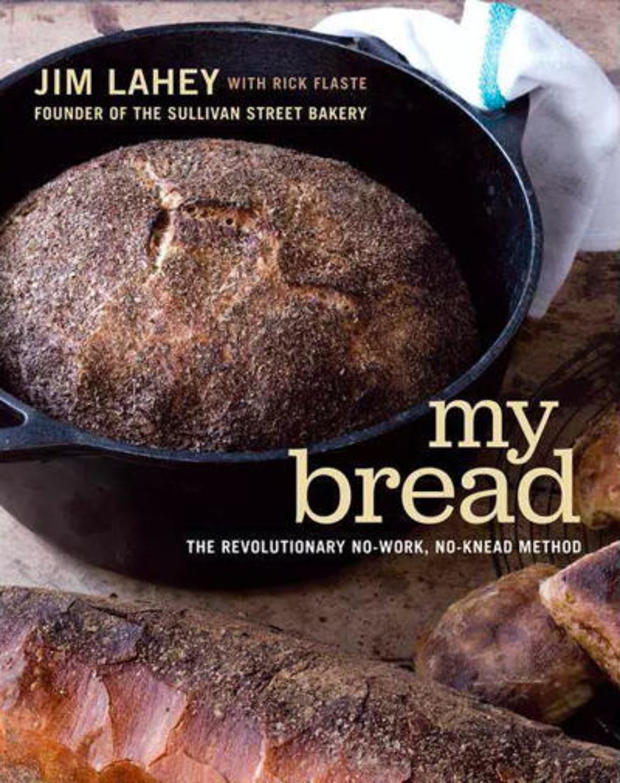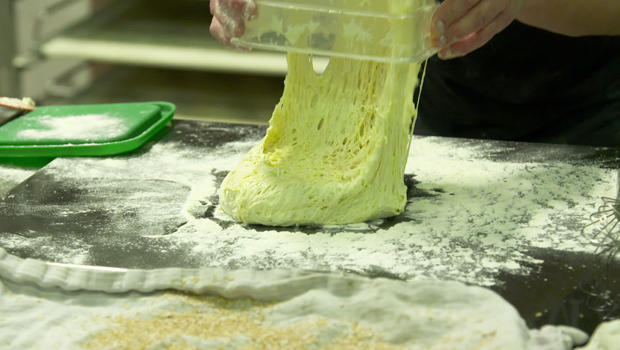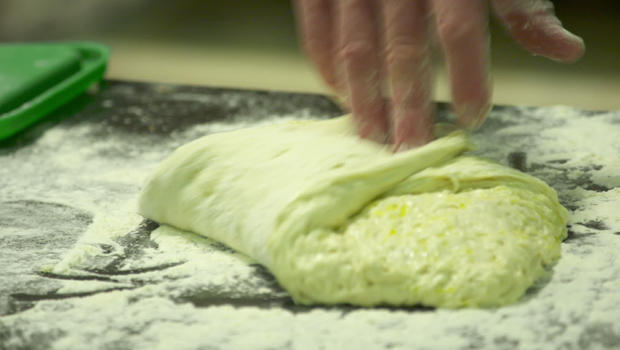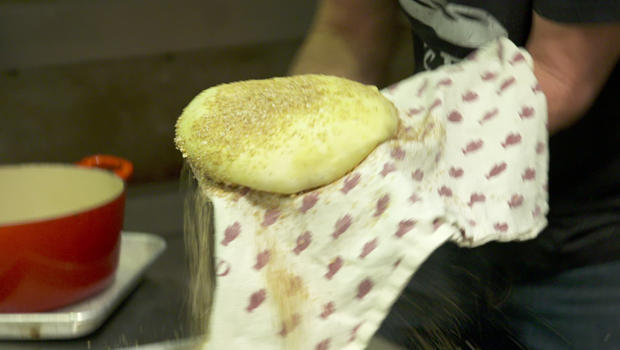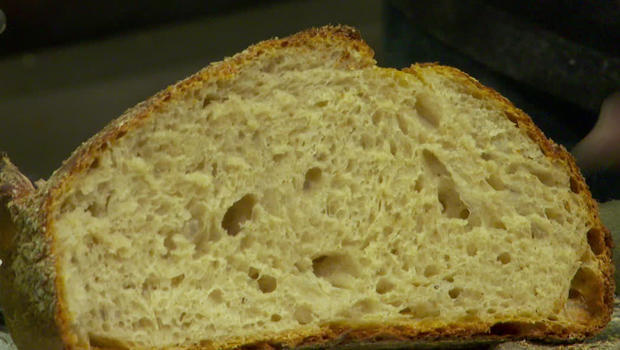Recipe: Jim Lahey's Basic No-Knead Bread
Jim Lahey, owner of New York City's Sullivan Street Bakery and author of several cookbooks, including "My Bread," offers his recipe for a delicious, long-fermented rustic bread. Advice: plan ahead!
Don't miss Martha Teichner's interview with Lahey in her May 24 "CBS Sunday Morning" report on baking bread!
Here's my basic no-knead, long-fermented rustic bread, a round loaf, or boule. It's an adaptation for the home kitchen of the much larger oval filone and the football-shaped pugliese sold at the Sullivan Street Bakery. I suggest you try this before any of the variations, to get the hang of it. Even if you've baked before, the process is probably nothing like what your experience would lead you to expect. For one thing, many people who bake this bread find the dough to be unusually wet. Remember that most of the water is meant to be released as steam in the covered pot, and you'll be handling the dough very little anyway.
Don't feel too uptight about any of this. For example, I specify that the dough should rise at room temperature, about 72 degrees Fahrenheit. (In many of the recipes, I say to put the dough in a warm, draft-free spot – same thing.) But if that's not what you have at the moment, you'll be okay anyway. Just pay attention to the visual cues: At the end of the first rise, the dough is properly fermented when it has developed a darkened appearance and bubbles, and long, thread-like strands cling to the bowl when it's moved. After the second, briefer, rise, the loaf has risen sufficiently if it holds the impression of your fingertip when you poke it lightly, making an indentation about 1/4 inch deep. It should hold that impression. If it springs back, let it rise for another 15 minutes.
Despite my own efforts to get this and all the other recipes in this book to reflect what I think is the optimal approach, conditions are going to vary from kitchen to kitchen. I hope you'll ultimately have the confidence to experiment yourself, adjusting the ingredients and timing to your own taste and circumstances. As the journalists who've reported on my bread have written, even the loaves that aren't what you'd regard as perfect are way better than fine.
On timing:
This bread is incredibly simple and involves little labor, but you need to plan ahead. Although mixing takes almost no time, the first rise requires from 12 to 18 hours. Then you'll need to shape the dough and let it rise for another 1 to 2 hours. The longer rise tends to result in a richer bread, but you need the patience and the schedule to do it. In any event, the shorter rise is acceptable, too: Just pay attention to the signs of a good rise described in the recipes. A reminder: The visual cues – a bubbly surface with a darkened appearance – are key. Usually, 18 hours is optimal. (Very cold weather exception: In the dead of winter, when the dough will tend to rise more slowly, a longer period may be necessary, as much as 24 hours.)
After preheating the oven and the pot, you've got 30 minutes of covered baking, another 15 to 30 of uncovered baking, and about an hour of cooling. And, please, don't gulp down that first slice. Think of the first bite as you would the first taste of a glass of wine: smell it (there should be that touch of maltiness), chew it slowly to appreciate its almost meaty texture, and sense where it came from in its hint of wheat. Enjoy it. You baked it, and you did a good job.
Recipe: Jim Lahey's Basic No-Knead Bread
Yield: One 10-inch round loaf; 1¼ pounds
Equipment: A 4½- to 5½-quart heavy pot
Ingredients:
3 cups bread flour
1 ¼ teaspoons table salt
¼ teaspoon instant or other active dry yeast
1 1/3 cups cool (55-65 degrees F) water
Wheat bran, cornmeal or additional flour for dusting
Instructions:
1. In a medium bowl, stir together the flour, salt, and yeast. Add the water and, using a wooden spoon or your hand, mix until you have a wet, sticky dough, about 30 seconds. Make sure it's really sticky to the touch; if it's not, mix in another tablespoon or two of water. Cover the bowl with a plate, tea towel, or plastic wrap and let sit at room temperature (about 72 degrees F), out of direct sunlight, until the surface is dotted with bubbles and the dough is more than doubled in size. This will take a minimum of 12 hours and (my preference) up to 18 hours. This slow rise – fermentation – is the key to flavor.
2. When the first fermentation is complete, generously dust a work surface (a wooden or plastic cutting board is fine) with flour. Use a bowl scraper or rubber spatula to scrape the dough onto the board in one piece. When you begin to pull the dough away from the bowl, it will cling in long, thin strands (this is the developed gluten), and it will be quite loose and sticky – do not add more flour. Use lightly floured hands or a bowl scraper or spatula to lift the edges of the dough in toward the center. Nudge and tuck in the edges of the dough to make it round.
3. Place a cotton or linen tea towel (not terry cloth, which tends to stick and may leave lint in the dough) or a large cloth napkin on your work surface and generously dust the cloth with wheat bran, cornmeal, or flour. Use your hands or a bowl scraper or wooden spatula to gently lift the dough onto the towel, so it is seam side down. If the dough is tacky, dust the top lightly with wheat bran, cornmeal, or flour. Fold the ends of the towel loosely over the dough to cover it and place it in a warm, draft-free spot to rise for 1 to 2 hours. The dough is ready when it is almost doubled. If you gently poke it with your finger, making an indentation about 1/4 inch deep, it should hold the impression. If it doesn't, let it rise for another 15 minutes.
4. Half an hour before the end of the second rise, preheat the oven to 475 degrees F, with a rack in the lower third position, and place a covered 4 ½- to 5 ½-quart heavy pot in the center of the rack.
5. Using pot holders, carefully remove the preheated pot from the oven and uncover it. Unfold the tea towel, lightly dust the dough with flour or bran, lift up the dough, either on the towel or in your hand, and quickly but gently invert it into the pot, seam side up. (Use caution – the pot will be very hot.) Cover the pot and bake for 30 minutes.
6. Remove the lid and continue baking until the bread is a deep chestnut color but not burnt, 15 to 30 minutes more. Use a heatproof spatula or pot holders to carefully lift the bread out of the pot and place it on a rack to cool thoroughly. Don't slice or tear into it until it has cooled, which usually takes at least an hour.
From "My Bread: The Revolutionary No-Work, No-Knead Method" by Jim Lahey with Rick Flaste, published by WW Norton. Reprinted with permission. All rights reserved.
For more info:
- "My Bread: The Revolutionary No-Work, No-Knead Method" by Jim Lahey with Rick Flaste (WW Norton), in Hardcover and eBook formats, available via Amazon
- Sullivan Street Bakery, New York City
See also:
- Recipe: French-Style Country Bread (King Arthur Flour)
- Recipe: Vermont Whole Wheat Oatmeal Honey Bread (King Arthur Flour)
- Recipe: Morning-of Breakfast Bread (Kriss Marion)
- Recipe: Pull-Apart Rolls (Food & Wine)
- Recipes: White Soda Bread and Scones (Ballymaloe Cookery School)
- Recipe: Irish Soda Bread with Stout Butter (Tupperware)
- Lockdowns have created a bread baking boom ("CBS This Morning")
